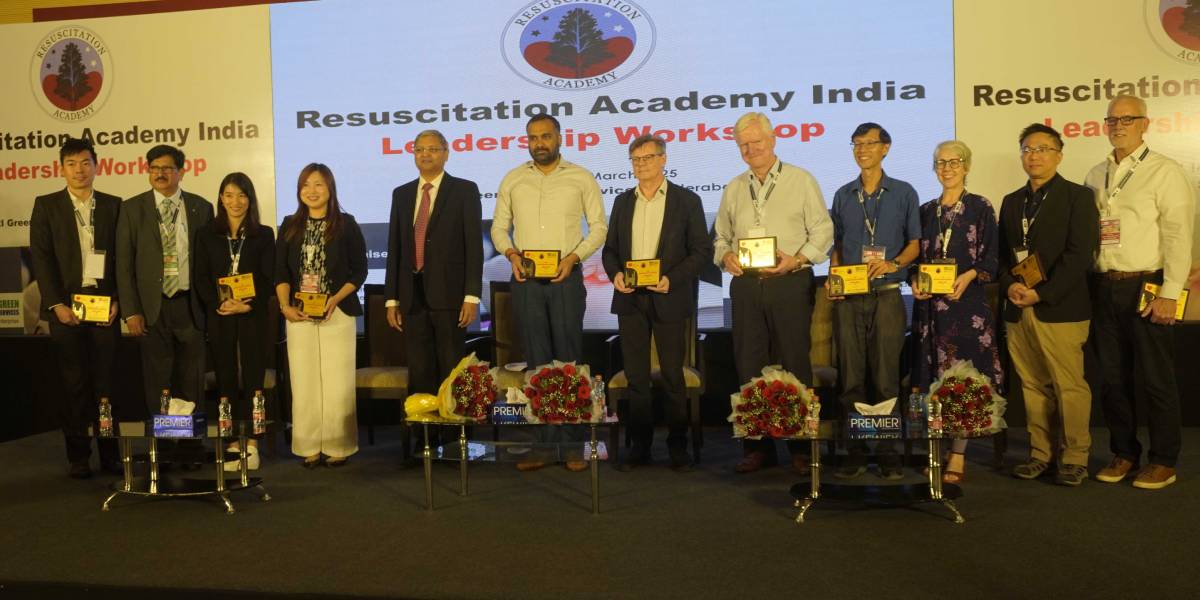One of the primary goals of the Resuscitation Academy is to enhance out-of-hospital cardiac arrest (OHCA) survival by strengthening pre-hospital emergency response systems.
Published Mar 16, 2025 | 10:19 AM ⚊ Updated Mar 16, 2025 | 10:19 AM

Officials at the inauguration of Resuscitation Academy India. (Supplied)
Synopsis: For the first time in India, a Resuscitation Academy has been established in Hyderabad to enhance survival rates in cases of sudden cardiac arrest (SCA). The Resuscitation Academy is a program dedicated to improving survival rates in cases of SCA through education, training, and system-wide improvements in emergency response.
You may have come across the viral video of a woman collapsing while dancing at her brother’s wedding party, who later died. Videos similar to that are viral on social media — whether from a gym session, a badminton court, or other everyday moments — showing people succumbing to sudden cardiac arrests.
India faces a staggering challenge with approximately 1.2 million cases of sudden cardiac arrest (SCA) annually.
Most of these individuals do not receive emergency medical help, such as resuscitation, which could potentially save their lives. Resuscitation is the process of restoring breathing and circulation in a person experiencing cardiac or respiratory arrest through techniques like CPR (cardiopulmonary resuscitation), defibrillation, and advanced life support.
When performed promptly, it is a critical intervention that can significantly improve survival and recovery rates.
For the first time in India, a Resuscitation Academy has been established to bring this knowledge to the people and enhance survival rates in cases of sudden cardiac arrest (SCA).
EMRI Green Health Services (EMRI GHS) launched India’s first Resuscitation Academy at its national headquarters in Hyderabad. This pioneering initiative joins a global network of 30 such academies, making India part of an international effort to enhance resuscitation training and emergency response.
The Resuscitation Academy is a program dedicated to improving survival rates in cases of sudden cardiac arrest (SCA) through education, training, and system-wide improvements in emergency response. Founded in Seattle in the Washington state of the US, the academy is associated with the Seattle Fire Department and the Medic One Foundation — organisations renowned for their high cardiac arrest survival rates.
One of the primary goals of the Resuscitation Academy is to enhance out-of-hospital cardiac arrest (OHCA) survival by strengthening pre-hospital emergency response systems. The program also focuses on improving high-performance CPR by training emergency responders in the most effective resuscitation techniques.
Another key objective is to encourage public participation by promoting widespread CPR training and the use of Automated External Defibrillators (AEDs). The academy also works to optimise Emergency Medical Services (EMS) performance by helping agencies refine their protocols and coordination efforts. Additionally, it emphasises advancing research and data utilisation to develop better cardiac arrest management strategies.
The program provides specialised training for EMS leaders, medical directors, and first responders, with the ultimate mission of helping communities achieve the highest possible survival rates for cardiac arrest.
India faces an alarming crisis in cardiac arrest survival rates. The country reports approximately 1.2 million cases of sudden cardiac arrest (SCA) annually, yet awareness of Cardiopulmonary Resuscitation (CPR) remains critically low at just tw percent, and instances of bystander CPR are rare.
These statistics highlight the urgent need for a nationwide resuscitation strategy to improve survival outcomes.
The Resuscitation Academy in India (RAI) has been established in partnership with the Global Resuscitation Alliance (GRA) to address these challenges.
Its primary objective is to enhance cardiac arrest survival rates across the country by implementing GRA’s 10 Steps, which are globally recognised as the gold standard for improving SCA outcomes. By 2030, RAI aims to increase the Return of Spontaneous Circulation (ROSC) in cardiac arrest cases from two percent to 10 percent in targeted regions.
The inaugural Leadership Workshop of the Resuscitation Academy in India was held at the EMRI Green Health Services (EMRI GHS) Campus. This residential workshop, which commenced on Thursday and concludes on Friday, has brought together over 75 participants, including practicing doctors from institutions such as NIMS and Apollo, government health officials, subject matter experts, and key leaders in emergency response.
The workshop is designed to support the implementation of the GRA’s 10 Steps to improve cardiac arrest survival rates. The Unit for Prehospital Emergency Care (UPEC), Ministry of Health, Government of Singapore, is serving as the technical partner for the workshop under the aegis of the Global Resuscitation Alliance.
In his opening remarks, Subodh Satyawadi, President of EMRI GHS, highlighted the organisation’s evolution from a small initiative in 2005 with just a few ambulances into a nationwide emergency care leader.
“Today, EMRI GHS operates a fleet of over 17,000 ambulances and has earned a reputation for excellence in pre-hospital emergency care. Through its various initiatives, EMRI GHS now provides emergency response services to nearly one billion people across India,” he said.
To date, the 108 emergency ambulance services operated by EMRI GHS have attended over 30 crore emergencies, saving 80 lakh lives and assisting 7.5 lakh deliveries within ambulances, Satyawadi added.
The Resuscitation Academy in India was officially inaugurated by RV Karnan, Commissioner of Health & Family Welfare, MD-NHM and CEO of Arogyasri Trust, Government of Telangana.
He emphasised the critical need for trauma care within the golden hour to improve patient outcomes.
“Telangana currently boasts one ambulance for every 64,500 people, significantly better than the national average, where the Ministry of Health and Family Welfare recommends a ratio of one Basic Life Support (BLS) and one Advanced Life Support (ALS) ambulance per 100,000 people. The state’s goal is to further improve this ratio to one ambulance per 50,000 people,” he said.
He added that with support from the World Bank, Telangana is strengthening its emergency medical response capabilities by setting up 100 trauma care centers across the state.
These efforts aim to enhance healthcare infrastructure and ensure that timely and life-saving interventions reach patients when they need them most, Karnan added.
(Edited by Muhammed Fazil.)
